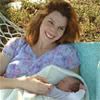Thursday, May 25, 2006
I have been working on the lace edging and I have been struggling to read the pattern. I have both versions (word and graph) of the vintage 1891 pattern printed out from the fantastic website resource of Sarah Bradbury....
http://www.knitting-and.com/homework/perfection-leaf-lace.htm
Anyway- I have to knit five hundred some odd rows of this 12 row repeat- and I'm just not getting the groove of it. I love how the lace looks- but I hate knitting it word by word and I keep hoping that I will memorize it- but my brain is just not grabbing on to these slippery jagged notations.
I wound up copy/pasting the text pattern and adding larger spaces between the pattern rows. Then I circled the rows with different colors of crayon, so I could visually return to "the red row" I think part of the problem is that the key first stitches of every other row of the pattern gradually go from 6 down to 1- but the numbering of the rows is such that the row number and the key number are not matched or relevant. Would it be easier to tell the knitter- "In this pattern you should count the rows of your pattern in reverse- starting with row twelve the row begins with six stitches... 12... 6... numbers make sense! As it is we have row 11 with starts with 4, row 9 with five and seven with 6.
Well- I misplaced my cheat sheet and had to print it out again and decided that rather than fight this dragon- I'm going to take it to the spa for a makeover. I redid the whole thing using photoshop and suddenly it become very readable (for me) I am very interested in the ways that people learn and the various types of "thinkers" and I'm curious to hear if other knitters like the chart that I made for this pattern- does it help you too?
It's read from bottom to top right to left, just like a chart. Between every pattern row- there is a plain knit (or purl as the case may be) row. The right edge of the chart is the straight edge of this edging. The large number represents a number of stitches to knit, / is a k2tog, and O is a yarn over. The pattern starts with a base of 28 cast on stitches.
Subscribe to:
Post Comments (Atom)


No comments:
Post a Comment